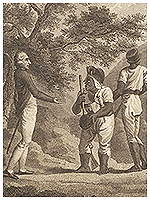 | 

 |
During the 18th century, the powerful Maroons, escaped ex-slaves who settled in the mountains of Jamaica, carved out a significant area of influence. Through the use of slave labor, the production of sugar in this British colony flourished. But the courageous resistance of the Maroons threatened this prosperous industry. These efforts included plantation raids, the killing of white militiamen, and the freeing of slaves. The threat to the system was clear and present; hence, the planters were willing to sign a treaty with the Maroons in 1738. The treaty offers good insight to the relationship between the planters and the Maroons at the time, and deserves further attention.
On March 1, 1738, the articles of pacification with the Maroons of Trelawny Town signaled to Jamaica that a new era was emerging. The English planters had feared the rising power of the Maroons, and therefore tried to subdue them. This proved to be unsuccessful, consequently causing the English to realize that making peace with the Maroons was the only possible solution. This treaty was the first of its kind and it demonstrated that a group of rebellious ex-slaves had forced a powerful class of planters to come to terms. This was an unlikely event during the eighteenth century, given the dominance of the planter class across the Caribbean. Yet the fact remains that the treaty did not solely serve the planters’ interest. For example, article three of the treaty states that the Maroons were given 1500 acres of crown land, a necessity for the Maroons to maintain their independent way of life. In addition, it made a boundary between the Maroons and the planters, which was to avoid future conflicts.

Another example of an unbiased stipulation is article eight of the treaty, which states: "that if any white man shall do any manner of injury to Captain Cudjoe, his successors, or any of his or their people, shall apply to any commanding officer or magistrate in the neighborhood for justice." This showed some equity under the law between the Maroons and the planters. Furthermore, the fifth article of the treaty specifies "that Captain Cudjoe, and all the Captain’s adherents, and people now in subjection to him, shall all live together within the bounds of Trelawny Town, and that they have liberty to hunt where they shall think fit, except within three miles of any settlement, crawl, or pen; provided always, that in case the hunters of Captain Cudjoe and those of other settlements meet, then the hogs to be equally divided between both parties." In other words, the English planters were willing to divide the game equally amongst themselves and the Maroons, but more importantly, they were giving the latter the liberty to hunt freely.
Although the articles of pacification granted the Maroons of Jamaica many privileges, it also attempted to limit their attacks against the system of slavery in general. There were hints of favoritism towards the planters, for example, article thirteen required that the Maroons continue to help clear roads from Trelawny Town to Westmoreland and if possible from St. James to St. Elizabeth. This was biased because, as free men, the Maroons were not entitled to labor for the planters. This showed that the planters viewed the Maroons to be inferior to them. Another bias in the treaty includes article eleven which states that "Captain Cudjoe, and his successors, shall wait on his Excellency, or the Commander in Chief for the time being, every year, if thereunto required." This article reveals an attempt to keep the Maroons subordinate and under control. In addition to article eleven, another article that reveals a biased attitude is article fourteen, which affirms that two white men shall live with the Maroons "in order to maintain a friendly correspondence with the inhabitants of this island." Even though this treaty was to encourage a friendly relationship between the two parties, it also gave white planters first-hand knowledge of the situation in the Maroon camp. Most important of all, the treaty also required the Maroons to act as a sort of police force for the planters, returning future runaways to the plantations, and drafting them to fight against future rebellions.
This treaty contained elements of fairness and favoritism that were evident through its articles. Some of these were beneficial to the Maroons, while others were not; however, the signing of the treaty indicated that the Maroons constituted a substantial threat to the planters. This treaty was not only ground breaking in that it recognized the Maroons and their needs, but also revealed that the English planters were fearful of the Maroons capabilities and ever-rising power.
|
| Bryan Edwards, On the Maroons, (London, 1794) XIX-XX |

 |






